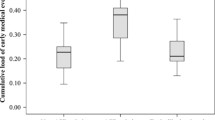Abstract
Factors modifying the clinical penetrance of DYT1 dystonia are incompletely defined. Particularly, the contribution of extragenetic factors has been subject to only limited investigation and remains largely unexplored. A possible effect of childhood infections has been proposed, and the effect of other factors, such as perinatal adversity and trauma, has not been systematically investigated. We performed an exploratory analysis of the exposure to perinatal adversity, childhood infections, general anaesthesia and trauma comparing 39 manifesting carriers of the ∆GAG mutation, 23 non-manifesting carriers and 48 non-carriers from a multi-centre European series of 28 families with DYT1 dystonia, by means of a self-completed questionnaire and clinical interview. Detailed information on perinatal adversities (pre-term birth, complications at natural delivery, urgent caesarean section), previous childhood infections, and prior general anaesthesia or physical trauma was recorded. A positive association between a history of complications of vaginal delivery and manifestation of dystonia was detected, which was not confounded by age, gender, or education level (odds ratio 8.47, 95 % confidence interval 1.45–49.4, p = 0.02). We could not observe any significant association between presence of dystonia and the other investigated variables. Comparing non-manifesting carriers to non-carriers, the presence of the ∆GAG mutation per se was not associated with any of the environmental exposures explored. Perinatal adversities might modulate the clinical penetrance of DYT1 dystonia; their interaction with known genetic factors modifying penetrance of this condition should be investigated in new, larger collaborative studies.
Similar content being viewed by others
References
Bressman SB, Raymond D, Wendt K, Saunders-Pullman R, De Leon D, Fahn S, Ozelius L, Risch N (2002) Diagnostic criteria for dystonia in DYT1 families. Neurology 59:1780–1782
Risch NJ, Bressman SB, Senthil G, Ozelius LJ (2007) Intragenic Cis and Trans modification of genetic susceptibility in DYT1 torsion dystonia. Am J Hum Genet 80:1188–1193
Frédéric MY, Clot F, Blanchard A et al (2009) The p.Asp216His TOR1A allele effect is not found in the French population. Mov Disord 24:919–921
Chen Y, Burgunder JM, Song W, Huang R, Shang HF (2012) Assessment of D216H DYT1 polymorphism in a Chinese primary dystonia patient cohort. Eur J Neurol 19:924–926
Saunders-Pullman R, Wendt KJ, Parides MJ et al (2000) Environmental modifiers of genetic dystonia: possible role of infection. Neurology 54(suppl 3):A198
Dressler D (2011) Nonprimary dystonias. In: Weiner WJ, Tolosa E (eds) Handbook of Clinical Neurology. Hyperkinetic movement disorders, vol 100 (3rd series). Elsevier, Amsterdam, pp 513–538
Burke RE, Fahn S, Gold AP (1980) Delayed-onset dystonia in patients with “static” encephalopathy”. J Neurol Neurosurg Psychiatry 43:789–797
Saint-Hilaire MH, Burke RE, Bressman SB, Brin MF, Fahn S (1991) Delayed-onset dystonia due to perinatal or early childhood asphyxia. Neurology 41:216–222
Cerovac N, Petrovic I, Klein C, Kostic V (2007) Delayed-onset dystonia due to perinatal asphyxia: a prospective study. Mov Disord 22:2426–2429
Gavarini S, Vayssière N, Delort P, Cif L, Biolsi B, Tancu C, Vasques X, Plagnol S, Bonafe A, Coubes P (2008) Stereotactic MRI in Dyt1 dystonia: focal signal abnormalities in the basal ganglia do not contraindicate deep brain stimulation. Stereotact Funct Neurosurg 86:245–252
Edwards MJ, Wood N, Bhatia K (2003) Unusual phenotypes in DYT-1 dystonia: a report of five cases and a review of the literature. Mov Disord 18:706–711
Gioltzoglou T, Milonas I, Lees AJ (2006) Case of DYT1 dystonia triggered by bite from a moray. Mov Disord 21:1536–1537
Sasco AJ, Paffenbarger RS Jr (1985) Measles infection and Parkinson’s disease. Am J Epidemiol 122:1017–1031
Martyn CN, Osmond C (1995) Parkinson’s disease and the environment in early life. J Neurol Sci 132:201–206
Conflicts of interest
The authors do not have any conflict of interest related to the research covered in the article.
Ethical standard
We state that the present study has been approved by the local ethics committee and has therefore been performed in accordance with the ethical standards laid down in the 1964 Declaration of Helsinki and its later amendments. As stated also in the Subjects and Methods section, all subjects gave their written informed consent prior to their inclusion in the study.
Author information
Authors and Affiliations
Corresponding author
Additional information
D. Martino and A. Gajos are joint first authors.
Rights and permissions
About this article
Cite this article
Martino, D., Gajos, A., Gallo, V. et al. Extragenetic factors and clinical penetrance of DYT1 dystonia: an exploratory study. J Neurol 260, 1081–1086 (2013). https://doi.org/10.1007/s00415-012-6765-2
Received:
Revised:
Accepted:
Published:
Issue Date:
DOI: https://doi.org/10.1007/s00415-012-6765-2




